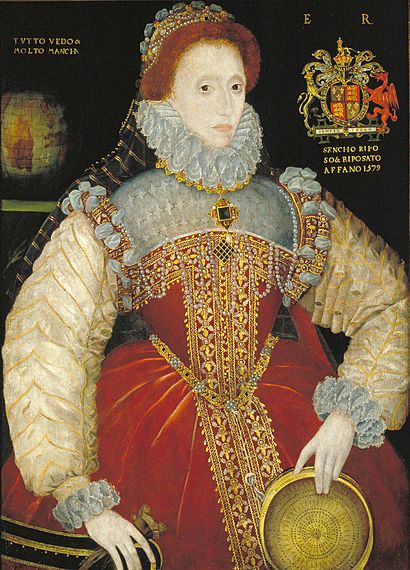Plimpton Sieve Portrait of Queen Elizabeth I facts for kids
Quick facts for kids Plimpton Sieve Portrait of Queen Elizabeth I |
|
|---|---|
 |
|
| Artist | George Gower |
| Year | 1579 |
| Medium | Oil on wood |
| Dimensions | 104.4 cm × 76.2 cm (41.1 in × 30.0 in) |
| Location | Folger Shakespeare Library, Washington, D.C. |
The Plimpton Sieve Portrait of Queen Elizabeth I is a famous oil painting created in 1579 by the English artist George Gower. This painting is now kept at the Folger Shakespeare Library in Washington, D.C.. It's special because it's one of three very similar paintings Gower made of Queen Elizabeth I. In these portraits, the Queen holds a sieve, which is a tool with a mesh used for sifting. The painting got its name because George Arthur Plimpton bought it in 1930. Later, his son, Francis T. P. Plimpton, gave it to the Folger Library.
Contents
What Does the Painting Show?
This painting shows Queen Elizabeth I from her waist up. She is holding a sieve in her hands. In the background, on the left side, you can see a globe, which is a model of the Earth. On the right side, there's the royal coat of arms, which is a special symbol for the Queen and her family.
Secret Messages in the Painting
The painting has three different messages written on it in yellow capital letters. These messages are in Italian and Latin, and they add to the painting's meaning.
What Do the Italian Phrases Mean?
- "TVTTO VEDO & MOLTO MANCHA" is written at the top left. This Italian phrase means "I see everything and much is lacking." It suggests that even though the Queen is powerful and sees everything, there might still be things missing or imperfect in her world.
- "STANCHO RIPOSO & RIPOSATO AFFANO 1579" is near the top right. This longer Italian phrase means "Weary, I have rested, and having rested, am breathless." It's a line from an old poem by Petrarch. The year 1579 is also written here, showing when the painting was finished.
What Does the Latin Phrase Mean?
- "E R" is at the top right, standing for "Elizabeth Regina." This is Latin for "Elizabeth the Queen." It's a simple way to identify the powerful person in the portrait.
Why is the Sieve Important?
The sieve in the painting is a symbol. In ancient times, a sieve was linked to a Roman story about a woman named Tuccia. She was accused of being unfaithful, but she proved her innocence by carrying water in a sieve without spilling a drop. By holding the sieve, Queen Elizabeth I was showing that she was pure, wise, and able to tell good from bad. It was a way to tell everyone that she was a fair and just ruler.
Are There Other Versions of This Painting?
Yes, there are at least two other versions of George Gower's Sieve Portrait. One of them is only known from an old description written in the 1700s. Another version, which is a bit smaller, is now owned by a private collector in Florida.

